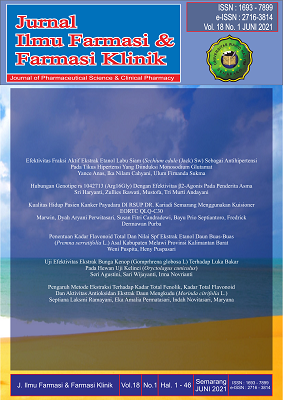Main Article Content
Abstract
Article Details
References
- BPOM, R.I., 2012, Pedoman Teknologi Formulasi Sediaan Berbasi Ekstrak, Vol. 2., Badan Pengawas Obat dan Makanan Republik Indonesia:Jakarta
- Chang, C.C., Yang., M.H., Wem, H.M. & Chern, J.C., 2002, Estimation of Total Flavonoid Content in Propolis by Two Complementary Colorimetric
- Methods, Journal of Food and Drug Analysis, Vol. 10 (3):178-182.
- Halimah, H., Suci, D.M., Wijayanti, I., 2018, Studi Potensi Penggunaan Daun Mengkudu (Morinda citrifolia L.) Sebagai Bahan antibakteri Escherichia coli dan Salmonella typhimurium, Jurnal Ilmu Pertanian Indonesia, Vol 24 (1): 56-64
- Hanani, E., 2014, Analisis Fitokimia, Buku Kedokteran EGC:Jakarta
- Harbone, J.B., 1987, Metode Fitokimia : Penuntun Cara Modern Menganalisa Tumbuhan, Penerbit ITB:Bandung
- Jamaludin, 2015, Pemberian Mengkudu Dalam Menunrunkan Tekanan Darah pada Pasien Hipertensi di Dukuh Susukan Desa Samirejo Kecamatan Dawe Kabupaten Kudus, Jurnal Profesi dan Keperawatan.
- Middleton Jr. E., Kandaswami, C., and Theoharis, C.T., 2000, The Effects of Plant Flavonoid on Mammalian Cells: Implication for Inflamation, Heart Disease and Cancer, Pharmacol Rev., 52 (4), 673-751
- Molyneux, P., 2004, The Use of The Stable Free Radical Diphenylpicrylhydrazyl (DPPH) for Estimating Antioxidant Activy, Journal of Science and Technology, 26(2), 211-219
- Pereira, D., M., Valentao, P., Pereira, J., A., dan Andrade, B., 2009, Phenolics : From Chemistry to Biology, Molecules, 14, 2202-2211.
- Rao, U.S.M., dan Subramanian, S. 2009, Biochemical Evaluation of Antihyperglycemic and Antioxidative Effects of Morinda citrifolia Fruit Extract Studied in Streptozotocin-Induced Diabetic Rats, Medicinal Chemistry Research, 18:433-446.
- Riskesdas, 2018. Badan Penelitian dan Pengembangan Kesehatan. Kemenkes RI : Jakarta.
- Rohman, A., Riyanto, S. dan Utari, D., 2006. Antioxidant Activities Total Phenolic and Flavonoid Contents Of Ethyl Acetate Extract Of Mengkudu (Morinda citrifolia L.) Fruit and Its Fractions. Majalah Farmasi Indonesia. 17 : 136-142
- Rohman, Abdul., Sugeng. R., Nurul K.H., 2007. Aktivitas Antioksidan Kandungan Fenolik Total dan Flavonoid Total Daun Mengkudu (Morinda citrifolia L.), Agritech (27)
- Sahoo, B., Nayak, N. C., Samantaray, A., and Pujapanda, P. K., 2012. Inorganic Chemistry. PHI Learning Pvt : Dehli
- Setiawan F., Yunita O., Kurniawan A., 2018, Uji Aktivitas Antioksidan Ekstrak Etanol Kayu Secang (Caesalpinia sappan) Menggunakan Metode DPPH, ABTS dan FRAP, Media Pharmaceutuca Indonesiana, Vol 2 (2), 82-89.
- Wigati. D., 2015. Efek Ekstrak Etanolik Daun dan Buah Morinda citrifolia L. Terhadap Tekanan Darah dan Gambaran Hispatologi Ginjal Tikus Hipertensi Terinduksi Deksametason. Tesis. Universitas Gajah Mada : Yogyakarta.
References
BPOM, R.I., 2012, Pedoman Teknologi Formulasi Sediaan Berbasi Ekstrak, Vol. 2., Badan Pengawas Obat dan Makanan Republik Indonesia:Jakarta
Chang, C.C., Yang., M.H., Wem, H.M. & Chern, J.C., 2002, Estimation of Total Flavonoid Content in Propolis by Two Complementary Colorimetric
Methods, Journal of Food and Drug Analysis, Vol. 10 (3):178-182.
Halimah, H., Suci, D.M., Wijayanti, I., 2018, Studi Potensi Penggunaan Daun Mengkudu (Morinda citrifolia L.) Sebagai Bahan antibakteri Escherichia coli dan Salmonella typhimurium, Jurnal Ilmu Pertanian Indonesia, Vol 24 (1): 56-64
Hanani, E., 2014, Analisis Fitokimia, Buku Kedokteran EGC:Jakarta
Harbone, J.B., 1987, Metode Fitokimia : Penuntun Cara Modern Menganalisa Tumbuhan, Penerbit ITB:Bandung
Jamaludin, 2015, Pemberian Mengkudu Dalam Menunrunkan Tekanan Darah pada Pasien Hipertensi di Dukuh Susukan Desa Samirejo Kecamatan Dawe Kabupaten Kudus, Jurnal Profesi dan Keperawatan.
Middleton Jr. E., Kandaswami, C., and Theoharis, C.T., 2000, The Effects of Plant Flavonoid on Mammalian Cells: Implication for Inflamation, Heart Disease and Cancer, Pharmacol Rev., 52 (4), 673-751
Molyneux, P., 2004, The Use of The Stable Free Radical Diphenylpicrylhydrazyl (DPPH) for Estimating Antioxidant Activy, Journal of Science and Technology, 26(2), 211-219
Pereira, D., M., Valentao, P., Pereira, J., A., dan Andrade, B., 2009, Phenolics : From Chemistry to Biology, Molecules, 14, 2202-2211.
Rao, U.S.M., dan Subramanian, S. 2009, Biochemical Evaluation of Antihyperglycemic and Antioxidative Effects of Morinda citrifolia Fruit Extract Studied in Streptozotocin-Induced Diabetic Rats, Medicinal Chemistry Research, 18:433-446.
Riskesdas, 2018. Badan Penelitian dan Pengembangan Kesehatan. Kemenkes RI : Jakarta.
Rohman, A., Riyanto, S. dan Utari, D., 2006. Antioxidant Activities Total Phenolic and Flavonoid Contents Of Ethyl Acetate Extract Of Mengkudu (Morinda citrifolia L.) Fruit and Its Fractions. Majalah Farmasi Indonesia. 17 : 136-142
Rohman, Abdul., Sugeng. R., Nurul K.H., 2007. Aktivitas Antioksidan Kandungan Fenolik Total dan Flavonoid Total Daun Mengkudu (Morinda citrifolia L.), Agritech (27)
Sahoo, B., Nayak, N. C., Samantaray, A., and Pujapanda, P. K., 2012. Inorganic Chemistry. PHI Learning Pvt : Dehli
Setiawan F., Yunita O., Kurniawan A., 2018, Uji Aktivitas Antioksidan Ekstrak Etanol Kayu Secang (Caesalpinia sappan) Menggunakan Metode DPPH, ABTS dan FRAP, Media Pharmaceutuca Indonesiana, Vol 2 (2), 82-89.
Wigati. D., 2015. Efek Ekstrak Etanolik Daun dan Buah Morinda citrifolia L. Terhadap Tekanan Darah dan Gambaran Hispatologi Ginjal Tikus Hipertensi Terinduksi Deksametason. Tesis. Universitas Gajah Mada : Yogyakarta.
